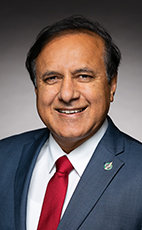44th Parl. 1st Sess.
May 18, 2023 10:00AM
- May/18/23 4:43:44 p.m.
- Watch
Madam Speaker, my hon. colleague spoke about the intention of the program. I do not deny that there are good intentions on all sides of the House when it comes to this issue. I am just interested in looking at the results.
The reason I see the Purdue program of overpromotion and of trying to minimize stigma about the substance to get more people to use it as very similar to, and in a substantive sense the same as, the safe supply program is that it was about flooding more supply of dangerous substances into the market, making them easier to access. At that time, and still today, that increase in supply is supposed to only go to certain people in certain kinds of situations. However, what we have seen is that when there is a big increase in the supply of dangerous drugs in the market, they do not only land in the hands of those who are supposed to get them. They land in the hands of children who have not used them before, and this increases the risks to everybody.
183 words
- Hear!
- Rabble!
- add
- star_border
- share
- May/18/23 4:44:46 p.m.
- Watch
Madam Speaker, today there was an article in the London Free Press entitled “London doctor rips ‘unfounded anecdotes’ about safe drug supply programs”. The article notes the ignorance that is going on with regard to ignoring medical research and evidence from the safe supply drug programs that are in place in this country and from the safe prevention sites. The article goes on to say, “the criticism presents a danger to harm-reduction policies across Canada”.
We need to follow evidence-based policies, and I would like an answer as to why the Conservatives are not following evidence-based policies.
106 words
- Hear!
- Rabble!
- add
- star_border
- share
- May/18/23 4:45:37 p.m.
- Watch
Madam Speaker, with great respect for my colleague, I get evidence from a variety of sources, which sometimes might include the London Free Press but does include broader reading than just one article that cites one physician.
The evidence we have seen over the last number of decades is very clear. When hard, dangerous drugs are destigmatized as substances and made more available and more accessible, then more people get them, more people use them and more people suffer and die as a result. Why would the government fund those kinds of programs when it could instead be investing in treatment and recovery?
103 words
- Hear!
- Rabble!
- add
- star_border
- share
- May/18/23 4:46:37 p.m.
- Watch
Madam Speaker, I will be sharing my time with my honourable and esteemed colleague from Longueuil—Charles-LeMoyne.
Before I begin my formal remarks, I note that all of us members of Parliament get to know our constituents and their families in our ridings and serve them to best of our ability. Sometimes we are called upon to go to a viewing at a funeral home when someone passes away. In the almost eight years that I have been a member of Parliament, I have been to many viewings to express my condolences to families, and I go there with the utmost humility and respect.
In one instance, I went to a viewing for a 26-year-old individual who had passed away from opioids. I know his father and the family well. I will never forget that evening. I will never forget seeing his childhood books from elementary school, which we keep as parents, and the memorabilia. This individual should have had a full and much longer life, but it was taken away from him.
I have been to many viewings, and when they are for folks in their eighties and nineties, we always say they lived full lives and God bless them; they are not suffering anymore. However, I will never forget the viewing of that young individual. He battled and lost his battle to the opioid crisis. That is the human face.
That is why we as parliamentarians and legislators need to make sure we are doing the right thing for our constituents. Evidence-based policy is the right thing. It is not Nancy Reagan's slogan to just say no to drugs. It is not an ideological stance, which I am seeing on the other side. It is none of that. It is doing what is right and what is evidence-based. That is how our government proceeds on a day-to-day basis, and that is how I feel I can best represent the constituents in my riding of Vaughan—Woodbridge.
As everyone in the House knows, the toxic drug supply and the overdose crisis are devastating communities across Canada. Before the COVID‑19 pandemic, 10 people died of drug overdose every day in Canada. Now we are losing 20 Canadians a day.
Over the past seven years of this crisis, many more people have been hospitalized, called emergency support services and mourned lives lost. These are our friends, our family members and people in our communities.
Unfortunately, today we are debating an ill-advised motion informed by outdated ideology. The motion recycles a simplistic, discredited approach. Instead, we could be talking about a comprehensive plan to address a crisis that is killing people.
Even former prime minister Stephen Harper's public safety adviser, Benjamin Perrin, saw the light and described the current Conservative approach, as represented by this motion, as a repetition of the Conservatives' long-discredited war-on-drugs thinking that has proven not only to be ineffective, but also costly and deadly.
An effective strategy to curb substance use relies on four internationally recognized pillars: prevention, treatment, enforcement, and risk reduction, including safer supply.
In December 2016, our government launched the Canadian drugs and substances strategy, which takes a public health approach to substance use. In doing so, we committed to a comprehensive, collaborative, compassionate and evidence-based drug policy.
As part of the Canadian drugs and substances strategy, the Government of Canada has taken evidence-based action to address the supply of toxic drugs and the overdose crisis, and has announced over $1 billion in funding. This funding includes nearly $500 million for Health Canada's substance use and addictions program to support community-based treatment, harm reduction, prevention and stigma reduction activities.
In addition, this funding has supported research and policing initiatives and strengthened the capacity of law enforcement agencies to combat illegal drug production and trafficking.
Going forward, the Canadian drugs and substances strategy will continue to guide our government's approach to drug policy, which includes a full continuum of evidence-based options, as well as innovative life-saving strategies to meet people where they are and provide the support they need.
Substance use is an extremely complex issue, and Canadians use drugs for a variety of reasons. Not everyone who uses drugs has an addiction. Even when a diagnosis exists, treatment services may not be available or affordable. Also, not everyone is willing or eligible for treatment. Recovery is different for everyone.
Services to keep people alive and safe, which contribute to better health outcomes, should not be limited to treating people with a formal diagnosis of a substance use disorder, since the crisis affects people who might be trying drugs for the first time, people who use them occasionally and people who are struggling in silence with an addiction.
There is no universal solution to this crisis. We need to have a range of measures that meet the needs of people where they are and that lower the risks of substance use. Risk reduction is a key aspect of this work and this government's strategy for dealing with the supply of toxic drugs and the overdose crisis.
The evidence shows us that risk reduction measures such as supervised consumption sites, virtual or in‑person assistance, safer supply, take-home naloxone and drug-checking technologies support the people who use drugs by putting them in contact with social and health services and, especially, by keeping them alive.
For example, in one of the hardest-hit provinces, the data gathered in British Columbia show that the combined effect of expanding access to the take-home naloxone program, the supervised consumption sites and opioid agonist therapy was crucial for preventing overdose deaths in the province.
What is more, between 2015 and 2021, nearly 125,000 naloxone kits were used to stop overdoses in British Columbia. In 2016, there was just one supervised consumption site in Canada. Since then, the number of supervised consumption sites approved by the federal government has increased to 41. They are offered in British Columbia, Alberta, Saskatchewan, Ontario and Quebec. That is because we are investing in what has been proven to work.
More than 46,000 overdoses have been reversed at these sites, which recorded more than 4 million visits. This point is worth repeating. These safe consumption sites, the same sites that the Conservative leader wants to shut down, have prevented more than 46,000 overdoses since 2017.
Those consumption sites have saved almost 50,000 Canadians from dying.
When we say that risk reduction goes wherever the people are at, this is what we mean. Risk reduction services are saving lives every day.
Assistance services offer support to people who use drugs, either in person or remotely by telephone, videoconference or an app. They also help in the event of an overdose. In its first 14 months of operation, the virtual National Overdose Response Service monitored more than 2,000 substance use-related events and responded to more than 50 adverse events. These events required an emergency response, but no deaths were reported.
I look forward to questions and comments from all of my colleagues.
1200 words
- Hear!
- Rabble!
- add
- star_border
- share
- May/18/23 4:56:41 p.m.
- Watch
Before going to questions and comments, it is my duty pursuant to Standing Order 38 to inform the House that the question to be raised tonight at the time of adjournment is as follows: the hon. member for Sherwood Park—Fort Saskatchewan, Public Services and Procurement.
47 words
- Hear!
- Rabble!
- add
- star_border
- share
- May/18/23 4:57:04 p.m.
- Watch
Mr. Speaker, the Conservative motion somehow implies that safe supply programs are not about fighting addiction, but really more about creating addiction. However, the evidence suggests that these programs are successful in reaching people with addictions more often on a daily basis, so that they can access more tailored recovery support services.
I wonder if my colleague could comment on the benefits of this approach, which may not be perfect in its current form. I would like him to talk about the possible benefits and the improvements that could be made to current programs.
94 words
- Hear!
- Rabble!
- add
- star_border
- share
- May/18/23 4:57:45 p.m.
- Watch
Mr. Speaker, I thank my colleague for his very important question.
Our program for reducing the number of overdoses is based on four pillars: harm reduction, getting drugs off the street, having a safe supply and having a safe treatment program for individuals who have unfortunately fallen dependent on these types of substances. These four pillars need to be working in unison and must be monitored to ensure they are working. We have estimated that the system has saved the lives of 46,000 people, which is something we need to speak to and look at.
We can always strengthen the system, yes, but we need to do it with an evidence-based approach.
114 words
- Hear!
- Rabble!
- add
- star_border
- share
- May/18/23 4:58:39 p.m.
- Watch
Mr. Speaker, I would like to hear a very specific answer to this question: How many treatment beds has the government added in its wonderful program, and how does the member justify the $3.5 million spent on vending machines to dispense high-potency opioids like hydromorphone?
47 words
- Hear!
- Rabble!
- add
- star_border
- share
- May/18/23 4:59:03 p.m.
- Watch
Mr. Speaker, I thank the hon. member for Cumberland—Colchester for his advocacy on health matters. I believe he is the health critic for the official opposition.
I will say this. Our government is continuing to invest money in treatment programs and a safe supply program for individuals who are unfortunately dependent on these drugs.
I remember many years ago walking into a Shoppers Drug Mart in the town my wife is from, and two young individuals were there getting a yellow mixture of water and a powder because they were dependent. We need to make sure these individuals avoid getting dependent on the substances they are on and that there is an available safe supply. That is exactly what they were doing that day, and I bet we saved their lives.
133 words
- Hear!
- Rabble!
- add
- star_border
- share
- May/18/23 4:59:59 p.m.
- Watch
Mr. Speaker, I would like to thank the hon. member for his very reasonable speech in response to the quite unreasonable motion before the House.
In doing so, I would like to ask if he agrees with me on this. On Vancouver Island, there are more than a dozen overdose prevention sites, which people like to call safe consumption sites. They save hundreds of lives every year, but they also help connect those with addiction problems to social services and treatment programs in the community.
Does he agree with me that the closure of those overdose prevention sites would contribute to more deaths and a larger number of addiction problems in the community?
113 words
- Hear!
- Rabble!
- add
- star_border
- share
- May/18/23 5:00:34 p.m.
- Watch
Mr. Speaker, I would like to thank my hon. colleague from Vancouver Island for his very informative and substantive question.
Those safe prevention sites are literally saving the lives of the most vulnerable in our society. We must always take care of our most vulnerable, and any closures of those sites would obviously be detrimental to them.
We as a government, me as a parliamentarian and all parliamentarians need to make sure we are assisting and taking care of the most vulnerable in our society, particularly those dependent on substances, who in fact could pass away from taking them if they do not receive treatment or a safe supply of alternative medicines.
112 words
- Hear!
- Rabble!
- add
- star_border
- share
- May/18/23 5:01:22 p.m.
- Watch
Mr. Speaker, this is a really important subject. The director of my constituency office just buried her nephew after his fentanyl overdose on the streets of Montreal. I do not think anyone in this House would disagree that the issue of overdoses and addictions is of great importance.
I would like to ask my hon. colleague if he would elaborate a bit more on how a safe supply is going to save people like the nephew of my constituency director.
80 words
- Hear!
- Rabble!
- add
- star_border
- share
- May/18/23 5:02:01 p.m.
- Watch
Mr. Speaker, I offer to my hon. colleague my sincerest condolences.
We all offer our sincerest condolences to any person in Canada who has lost a loved one due to this crisis. We as a government must maintain and look at evidence-based policies, which can assist Canadians from having to go through this scenario. We will be there for them.
In this case, I offer again my sincerest prayers for this young individual whose life was cut short because of this.
82 words
- Hear!
- Rabble!
- add
- star_border
- share
- May/18/23 5:02:45 p.m.
- Watch
Mr. Speaker, as everyone sitting in this House knows, the toxic drug supply and overdose crisis is devastating communities throughout Canada. We are losing 20 Canadians a day. Prior to COVID, 10 people were fatally overdosing every day in Canada, but now it has increased. Many more of our friends, family members and community members are being hospitalized, calling emergency support for services and grieving lives lost over the past seven years of this crisis.
Unfortunately, we are now debating a misguided motion rooted in outdated ideology that will recycle a discredited, narrow approach rather than create a comprehensive plan to deal with a crisis that is killing people. Even former prime minister Stephen Harper's public safety adviser, Benjamin Perrin, has seen the light and describes the current Conservative approach, which is epitomized by this motion, as “rehashing Conservative, war-on-drugs tropes that have been long since discredited and have been found to be not only ineffective, but costly and deadly.”
There are four pillars recognized internationally that are necessary for a successful substance use strategy: prevention, treatment, enforcement and harm reduction, including a safer supply. In December 2016, our government launched the Canadian drugs and substances strategy, which uses a public health approach to substance use. In doing so, we committed to a comprehensive, collaborative, compassionate and evidence-based drug policy.
Under the Canadian drugs and substances strategy, the Government of Canada has taken evidence-based action to address the toxic drug supply and overdose crisis and has announced over $1 billion in funding. This funding includes $490 million through Health Canada's substance use and addictions program to support community-based treatment, harm reduction, prevention, and stigma reduction activities. In addition, this funding has supported research and surveillance initiatives and strengthened law enforcement capacity to address illegal drug production and trafficking. Going forward, the Canadian drugs and substances strategy will continue to guide our government's drug policy approach, which includes a full continuum of evidence-based options, as well as innovative life-saving strategies to meet people where they are and provide them with the supports they need.
Substance use is an extremely complex issue, and Canadians use drugs for a multitude of reasons. Not everyone who uses drugs is suffering from an addiction. Even when a diagnosis exists, treatment services may not be available or affordable. Moreover, not everyone is always willing, eligible or able to enter treatment. Recovery looks different for everyone. Services to keep people alive and safe and that support better health outcomes should not be limited to just treatment services for people with a formal diagnosis of a substance use disorder, given the crisis is affecting people trying drugs for the first time, people who use drugs occasionally and people who are struggling with an addiction in silence.
There is no one-size-fits-all solution to this crisis. We need a range of interventions that meet people where they are and reduce the potential harms related to substance use. Harm reduction is a key element of that work and this government's strategy to address the toxic drug supply and overdose crisis.
Evidence has shown us that harm reduction measures, such as supervised consumption sites, in-person or virtual spotting services, safer supply, take-home naloxone, and drug-checking technologies, are supporting people who use drugs by connecting them to health and social services and, most importantly, are keeping them alive. For example, in one of the hardest hit provinces, evidence in British Columbia has shown that the combined effect of expanded access to take-home naloxone programs, supervised consumption sites and opioid agonist treatment has been crucial to averting overdose deaths in the province. In addition, between 2015 and 2021, nearly 125,000 naloxone kits were used to reverse an overdose in B.C.
In 2016, there were only two supervised consumption sites in Canada, both in Vancouver. Since then, the number of federally approved supervised consumption sites offering services has grown to as high as 40, and they are available in British Columbia, Alberta, Saskatchewan, Ontario and Quebec. This is because we are investing in what works and where the evidence is. At these sites, more than 46,000 overdoses have been reversed, and there have been over four million visits. That is a point worth repeating.
The safe consumption sites the Conservative leader wants to shut down have reversed more than 46,000 overdoses since 2017. When we say that harm reduction meets people where they are, this is what we mean. These harm reduction services are saving lives every day. Spotting services support someone who is using drugs either in person or remotely by phone, video chat or an app, and they provide help in case an overdose occurs.
During the first 14 months of operations, the virtual national overdose response service monitored over 2,000 substance use events and responded to over 50 adverse events. These events required an emergency response and no fatalities were reported.
Although the Conservative opposition will tell us otherwise, harm reduction efforts are not antithetical to treatment. They are part of the continuum of care. They meet people where they are, and they can connect people with a spectrum of health and social supports.
877 words
- Hear!
- Rabble!
- add
- star_border
- share
- May/18/23 5:12:49 p.m.
- Watch
Mr. Speaker, during today's debate, the Liberals have been conflating safe supply and safe consumption sites. They are two separate policies. The reality is that the member for Brampton Centre said safe consumption sites saved 45,000 lives.
However, anyone who has spent some time on the Downtown Eastside or in the Fraser Health region in my community, which has even higher overdose death rates than Vancouver, knows that someone who has an overdose could receive good care from there, but that is not preventing them from accessing and using fentanyl and other illicit drugs in conjunction with the free drugs they are getting from safe supply providers.
If the policies the government is pushing so hard are good, why do the death rates continue to increase in my community? Why do the death rates across British Columbia continue to increase? Why have the death rates continued to increase since the government decriminalized fentanyl?
155 words
- Hear!
- Rabble!
- add
- star_border
- share
- May/18/23 5:13:59 p.m.
- Watch
Mr. Speaker, harm reduction is a major concern here and evidence-based strategies are a major player here to save lives. We know, prior to 2015, we did not have safe spaces, but with this strategy, we have more safe centres where harm reduction and assistance are being provided. We are saving lives by doing that.
56 words
- Hear!
- Rabble!
- add
- star_border
- share
- May/18/23 5:15:02 p.m.
- Watch
Mr. Speaker, one of the things I like about the pilot projects created by Health Canada is the range of services provided to users. I am mainly referring to medical care and mental health counselling. The federal government certainly has a part to play in the fight against the opioid crisis, but I think that Quebec and the provinces do as well.
That requires federal health transfers. The 10-year funding that the provinces and Quebec asked for is not at all what they got. The federal government only gave them one-sixth of what they were asking for. Currently, in Quebec alone, more than 20,000 people are on a wait list for mental health services.
I think that what is being established at this time is very good, but does my colleague agree with me that the federal government must provide more funding for health care?
148 words
- Hear!
- Rabble!
- add
- star_border
- share
- May/18/23 5:16:07 p.m.
- Watch
Mr. Speaker, at supervised consumption sites in Canada, there have been more than 236,000 referrals to health and social services. These referrals are supporting individuals on their path to recovery and wellness, so that means the plan is working.
40 words
- Hear!
- Rabble!
- add
- star_border
- share
- May/18/23 5:16:45 p.m.
- Watch
Mr. Speaker, I thank the member for Brampton Centre for his quite measured speech on what is an unmeasured or moderate resolution from the Conservatives.
I wonder if he agrees with me on something. The Conservatives seem to be conflating safe supply with new addictions and it is certainly not the case. Safe supply is a way of keeping those who are already suffering from addictions, suffering from substance use problems, alive until we can get them into treatment and we can get them out of the situations that have led to their dire circumstances.
Does he agree with me that safe supply is certainly essential to preventing loss of life in our communities?
114 words
- Hear!
- Rabble!
- add
- star_border
- share
- May/18/23 5:17:26 p.m.
- Watch
Mr. Speaker, health care professionals, including those operating safe supply services, must follow federal rules around the secure handling of controlled substances, including measures to help prevent diversions.
28 words
- Hear!
- Rabble!
- add
- star_border
- share
- menumenu
- notificationsnotifications
- home
- mailmail
- searchsearch












